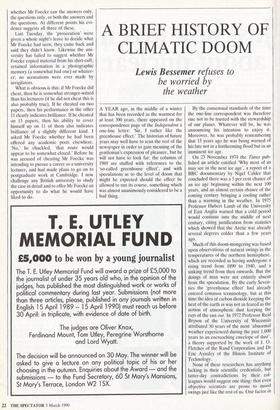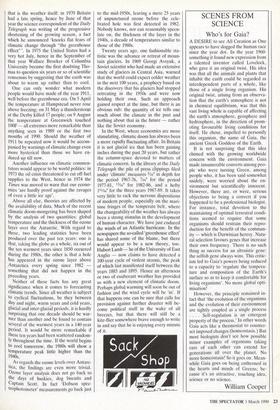A BRIEF HISTORY OF CLIMATIC DOOM
Lewis Bessemer refuses to
be worried by the weather
A YEAR ago, in the middle of a winter that has been recorded as the warmest for at least 300 years, there appeared on the correspondence page of the Independent a one-line letter: 'Sir, I rather like the greenhouse effect.' The historian of future years may well have to scan the rest of the newspaper in order to gain meaning of the gentleman's expression of pleasure, but he will not have to look far: the columns of 1989 are stuffed with references to the 'so-called greenhouse effect', and with speculations as to the level of doom that might be expected should the effect be allowed to run its course, something which was almost unanimously considered to be a bad thing. By the consensual standards of the time the one-line correspondent was therefore one not to be trusted with the stewardship of our planet. Whatever will be, he was announcing his intention to enjoy it. Moreover, he was probably remembering that 15 years ago he was being warned of his fate not in a forthcoming flood but in an imminent ice age.
On 23 November 1974 the Times pub- lished an article entitled 'Why most of us may see in the next ice age', a report of a BBC documentary by Nigel Calder that concluded there was a 5 per cent chance of an ice age beginning within the next 100 years, and an almost certain chance of the coming century bringing a cooling rather than a warming in the weather. In 1975 Professor Hubert Lamb of the University of East Anglia warned that a cold period would continue into the middle of next century, citing justification from statistics which showed that the Arctic was' already several degrees colder than a few years ago.
Much of this doom-mongering was based upon observations of natural swings in the temperatures of the northern hemisphere, which are recorded as having undergone a rising trend from 1890 to 1940, and a sinking trend from then onwards. But the doings of man were not entirely absent from the speculation. By the early Seven- ties the 'greenhouse effect' had already entered common terminology, but at this time the idea of carbon dioxide keeping the heat of the earth in was not as feared as the notion of atmospheric dust keeping the rays of the sun out. In 1972 Professor Reid Bryson of the University of Wisconsin attributed 50 years of the most 'abnormal weather experienced during the past 1,000 years to an encroaching envelope of dust', a theory supported by the work of J. 0. Fletcher of the Rand Corporation and Dr Eric Aynsley of the Illinois Institute of Technology.
None of these researchers has anything lacking in their scientific credentials, but latter-day contradictions by their col- leagues would suggest one thing: that even objective scientists are prone to mood swings just like the rest of us. One factor in
that is the weather itself: in 1970 Britain had a late spring, hence by June of that year the science correspondent of the Daily Telegraph was writing of the progressive shortening of the growing season, a fact which he announced 'knocks flat fears of climatic change through "the greenhouse effect"', In 1975 the United States had a very hot July, hence in the September of that year Wallace Broeker of Columbia University became the first doubting Tho- mas to question six years or so of scientific consensus by suggesting that the earth was about to warm up rather than to cool.
One can only wonder what modern people would have made of the year 1911, well before the greenhouse era. On 5 April the temperature at Hampstead never rose above freezing; on 31 May a thunderstorm at the Derby killed 17 people; on 9 August the temperature at Greenwich touched 100E—. all extremes more remarkable than anything seen in 1989 or the first two months of 1990. Should the weather of 1911 be repeated now it would be accom- panied by warnings of climatic change even more hysterical than those we have en- dured up till now.
Another influence on climatic commen- tators would appear to be world politics: in 1973 the oil crisis threatened to cut off fuel supplies to the West, hence in 1974 the Times was moved to warn that our econo- mies 'are hardly proof against the ravages of even a little ice age'.
Above all else, theories are affected by the availability of data. Much of the recent climatic doom-mongering has been shaped by the analysis of two quantities: global temperature and the thickness of the ozone layer over the Antarctic. With regard to these, two leading statistics have been produced over the past ten years: one is that, taking the globe as a whole, six out of the ten warmest years since 1850 occurred during the 1980s, the other is that a hole has appeared in the ozone layer above Antarctica every spring since 1982 — something that did not happen in the Preceding years.
Neither of these facts has any great Significance when it comes to forecasting Climatic trends. Since all weather is subject to cyclical fluctuations, be they between day and night, warm years and cold years, glacial and inter-glacial periods, it is hardly surprising that one decade should be war- mer than another and be found to contain several of the warmest years in a 140-year period. It would be more remarkable if these ten years had been scattered random- ly throughout the time. If the world begins to cool tomorrow, the 1980s will show a temperature peak little higher than the 1940s.
As regards the ozone levels over Antarc- tica, the findings are even more trivial. Ozone layer analysis does not go back to the days of huskies, dog biscuits and Captain Scott. in fact 'Dobson spec- trophotometer' measurements go back just to the mid-1950s, leaving a mere 25 years of unpunctured ozone before the cele- brated hole was first detected in 1982. Nobody knows, nor can reasonably specu- late on, the thickness of the layer in the 1940s, a decade of temperatures similar to those of the 1980s.
Twenty years ago, one fashionable sta- tistic was the advance or retreat of moun- tain glaciers. In 1969 Georgi Avsyuk , a Soviet scientist who had made an extensive study of glaciers in Central Asia, warned that the world could expect colder weather in the next 100 years, a prophecy based on the discovery that his glaciers had stopped retreating in the 1950s and were now holding their own. Such an approach gained respect at the time, but there is an obvious rub: the quantity of ice tells one much about the climate in the past and nothing about that in the future — rather like the Soviet economy.
In the West, where economics are more stimulating, climatic doom has always been a more rapidly fluctuating affair. In Britain it is not glacial ice that has been gaining inches during the past 20 years, but rather the column-space devoted to matters of climatic concern. In the library at the Daily Telegraph the pile of press clippings filed under 'climate' measures 5/10 in depth for the period 1967-76, 7/16" for the period 1977-81, 13/16" for 1982-86, and a hefty 1"/16" for the three years 1987-89. It takes very little to rack the nervous dispositions of modern people, especially on the mari- time fringes of the temperate belt, where the changeability of the weather has always been a strong stimulus in the development of human character. We have just endured the winds of an Atlantic hurricane. In the newspapers the so-called 'greenhouse effect' has shared some of the blame, but there would appear to be a new theory, too. Hubert Lamb — he of the University of East Anglia — now claims to have detected a 100-year cycle of violent storms, the peak of which last manifested itself between the years 1885 and 1895. Hence an afternoon or two of exuberant weather has provided us with a new element of climatic doom. Perhaps global, warming will soon be out of fashion and the wind cycle will be 'in'. If that happens one can be sure that calls for provision against further disaster will be- come political stuff in the wake of all breezes, but that there will still be a kite-flier somewhere brave enough to write in and say that he is enjoying every minute of it.



























































 Previous page
Previous page